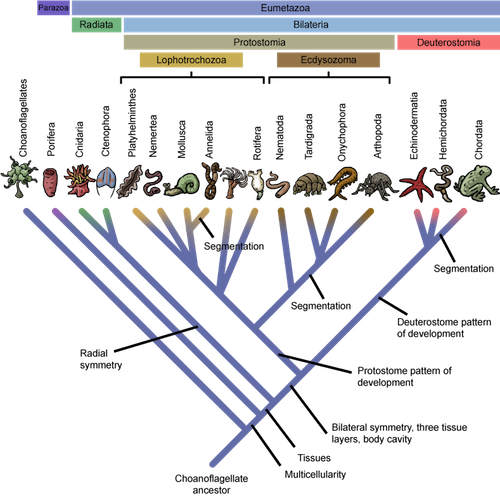Taxonomy Questions
Bring on the tough stuff
1. Would you expect the genetic sequences of a dog to be more similar to a wolf or a cow? What can you then guess about their relatedness?
2. If you had to divide one of the existing kingdoms into two or more other kingdoms, which would make the most sense to split? Why?
3. List 3 advantages to the binomial system of nomenclature.
4. What is the difference between protostomes and deuterostomes?
5.
Updated cladogram of major animal phyla based on genetic analysis. The colored labels on top of the diagram mark clades.
Using the picture above as your guide, into which phylum would you place an animal that has 3 tissue layers, develops an anus from its blastopore during development, and exhibits segmentation?
6.

Two styles of cladogram, each showing the same thing. Species A, B, and C all belong to the same clade. Node 1 represents an ancestor that is common to species A, B, and C. Node 2 represents an ancestor that is only common to species B and C.
In Figure 3 (above), which species is the oldest?
7. Make a cladogram of the 4 clades of plants: bryophytes, vascular seedless plants, gymnosperms, and angiosperms. Label the common ancestor and use an arrow to show when seeds evolved.
8. You have to classify a newly discovered organism. If you had to classify it based on a complete, detailed fossil or its genomic sequence, which would you choose and why?
9. Life in the water is generally easier to maintain than life on land. Most mammals are land dwelling but whales are not. Is it more likely that whales are one of the earliest mammals or that a land dwelling, mammalian predecessor of the whale "climbed back into the water"? Why?
10. Which protist, amoebas or green algae, was most likely the ancestor of all plants? Why?
Answers
1. Would you expect the genetic sequences of a dog to be more similar to a wolf or a cow? What can you then guess about their relatedness?
The wolf genome is quite similar to the dog genome. This makes sense when you compare all of their visible similarities: fur, paws, canine teeth, ears, etc. Cows, on the "udder" hand, have bristly hair, hooves, flat teeth, and horns. We can then conclude that dogs and wolves share a more recent common ancestor than dogs and cows.
2. If you had to divide one of the existing kingdoms into two or more other kingdoms, which would make the most sense to split? Why?
Protista, because each phylum is very different from the others. There isn't as much unity/similarity among members of this kingdom as there is within the other kingdoms.
3. List 3 advantages to the binomial system of nomenclature.
Names are in a common language, Latin.
Names are short.
Names are unique.
Names are universal.
4. What is the difference between protostomes and deuterostomes?
The blastopore in developing protostomes becomes the mouth of the adult organism; it becomes the anus in deuterostomes.
5.
Updated cladogram of major animal phyla based on genetic analysis. The colored labels on top of the diagram mark clades.
Using the picture above as your guide, into which phylum would you place an animal that has 3 tissue layers, develops an anus from its blastopore during development, and exhibits segmentation?
Chordata
6.

Two styles of cladogram, each showing the same thing. Species A, B, and C all belong to the same clade. Node 1 represents an ancestor that is common to species A, B, and C. Node 2 represents an ancestor that is only common to species B and C.
In Figure 3 (above), which species is the oldest?
1- because it is the common ancestor of species A, B, C, and 2.
7. Make a cladogram of the 4 clades of plants: bryophytes, vascular seedless plants, gymnosperms, and angiosperms. Label the common ancestor and use an arrow to show when seeds evolved.

8. You have to classify a newly discovered organism. If you had to classify it based on a complete, detailed fossil or its genomic sequence, which would you choose and why?
The genomic sequence will give more detailed information. Every structural detail preserved in the fossil will be reflected in the genetic information anyway. The genetic sequence will also allow you to quantify how similar the organism is to its related species and approximately when it evolved.
9. Life in the water is generally easier to maintain than life on land. Most mammals are land dwelling but whales are not. Is it more likely that whales are one of the earliest mammals or that a land dwelling, mammalian predecessor of the whale "climbed back into the water"? Why?
The latter option—mammals have many adaptations that help them survive on land: their young are kept hydrated during development by developing within their mothers; their hearing is adapted for sound waves travelling through the air instead of the water; mammary glands nourish and hydrate their vulnerable young after they are born; they are warm-blooded. There is no good reason for these traits to have developed in a water dwelling creature. Whales have actually had to further adapt in order to compensate for this, such as lots of blubber to keep them warm.
10. Which protist, amoebas or green algae, was most likely the ancestor of all plants? Why?
Green algae. They are green, so you can make a good guess that they contain chlorophyll and undergo photosynthesis. They also happen to have cell walls with cellulose, just like plants, but we didn't expect you to know that.